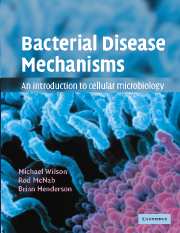Book contents
- Frontmatter
- Contents
- Preface
- Abbreviations used
- Chapter 1 An introduction to bacterial diseases
- Chapter 2 Bacterial cell biology
- Chapter 3 Molecular analysis of bacterial virulence mechanisms
- Chapter 4 Communication in infection
- Chapter 5 The mucosal surface: the front line of antibacterial defence
- Chapter 6 Immune defences against bacteria
- Chapter 7 Bacterial adhesion as a virulence mechanism
- Chapter 8 Bacterial invasion as a virulence mechanism
- Chapter 9 Bacterial exotoxins
- Chapter 10 Bacterial evasion of host defence mechanisms
- Chapter 11 Bacteria in human health and disease: the future?
- Appendix A Glossary of terms used
- Appendix B Brief descriptions of bacteria frequently mentioned
- Index
- Plate section
Chapter 8 - Bacterial invasion as a virulence mechanism
Published online by Cambridge University Press: 05 June 2012
- Frontmatter
- Contents
- Preface
- Abbreviations used
- Chapter 1 An introduction to bacterial diseases
- Chapter 2 Bacterial cell biology
- Chapter 3 Molecular analysis of bacterial virulence mechanisms
- Chapter 4 Communication in infection
- Chapter 5 The mucosal surface: the front line of antibacterial defence
- Chapter 6 Immune defences against bacteria
- Chapter 7 Bacterial adhesion as a virulence mechanism
- Chapter 8 Bacterial invasion as a virulence mechanism
- Chapter 9 Bacterial exotoxins
- Chapter 10 Bacterial evasion of host defence mechanisms
- Chapter 11 Bacteria in human health and disease: the future?
- Appendix A Glossary of terms used
- Appendix B Brief descriptions of bacteria frequently mentioned
- Index
- Plate section
Summary
Aims
The principal aims of this chapter are:
to explain what is meant by the term ‘invasion’
to describe the various mechanisms underlying bacterial invasion of host cells
to emphasise that invasion involves bacterial manipulation of the signalling pathways and cytoskeleton of the host cell
to provide examples of invasive organisms and the diseases associated with them
to indicate the consequences of invasion for both the bacterium and the host cell
to describe the different ways in which bacteria can survive within the host cell
Introduction
We have seen in Chapters 1 and 7 that the ability of a bacterium to adhere to a body surface (the mucosa or skin) or structure (e.g. a tooth) is an attribute of many organisms and is not limited to those species that induce disease. Hence, colonisation of epithelial surfaces by members of the normal microflora is, ultimately, of benefit to the host as it can protect against the adhesion of pathogenic species. The adhesion of such benign organisms rarely results in a pathological process, unless the host defences are defective in some way, for example in an immunocompromised individual. However, for some organisms, adhesion is only the first step in a pathological process that involves invasion of the host. Invasion of the epithelium may result in penetration of the organism to only the superficial layers of tissue, as in the case of cholera and gonorrhoea or it may, ultimately, involve deeper penetration, resulting in dissemination of the organism throughout the body.
- Type
- Chapter
- Information
- Bacterial Disease MechanismsAn Introduction to Cellular Microbiology, pp. 405 - 465Publisher: Cambridge University PressPrint publication year: 2002
- 3
- Cited by



